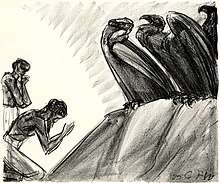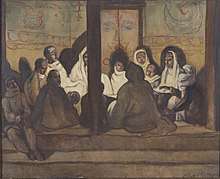Charles Freegrove Winzer
Charles Freegrove Winzer (1886-1940) was a British painter and lithographer. He lived in Paris, and was interned by Germany in World War I. Afterwards, he worked in Sri Lanka, until retirement to Vienna. He is widely regarded as a leading light in the introduction of modern art to Sri Lanka.
| Charles Freegrove Winzer | |
|---|---|
| Born | 1886 London |
| Died | 1940 Warneford Hospital |
| Occupation | Painter, lithographer, illustrator |
| Family | Alice Winzer |
_-_Charles_Freegrove_Winzer.jpg)
Early life
Winzer was born in London in 1886, of German descent,[1] and was educated there and in Warsaw.[2][lower-alpha 1]
He moved to Paris, where he became a close friend of Matisse.[1]
Career

From 1909 he exhibited at the Salon d’Automne in Paris.[3] His "distraught sketches" were exhibited alongside the work of the Camden Town Group at the Carfax Gallery in 1912.[4] He had a solo exhibition at the Ashnur Gallery in 1914.[2]
His sister, Alice, married his friend and fellow artist, the German Götz von Seckendorff. In 1914, during World War I, Seckendorff was killed in action. Winzer, who at the time was living in Paris and working for the French Red Cross, applied for permission to visit Alice in Germany, which the military authorities there granted. However, he was detained while attempting to leave Germany, and was interned at Ruhleben internment camp. While there, he provided illustrations for the camp magazine.[5][6]
From 1920, he served as Inspector of Art in the Education Department of the Government of Ceylon (now Sri Lanka).[1] In 1928, he founded the Ceylon Art Club.[1] In 1930, his paintings were included in the Beling and Keyt Exhibition in Colombo,[1] featuring work by George Keyt and Geoffrey Beling, who were his pupils.[7] After retiring from his role in Ceylon, in 1932, he settled in Venice.[8]
During his artistic career, he also worked in Morocco, Spain, India, and Nepal.[2]
Death and legacy

Winzer died at Warneford Hospital, Oxford, on 19 February 1940. The following year, The Winzer Memorial Exhibition of Paintings and Drawings took place at Colombo Art Gallery.[1]
His works are in numerous collections including several lithographs from Ruhleben, now in the Australian War Memorial collection.[6][9] His 1929 oil painting, Music for Ganesha (or Hymne a Ganesha), is in the National Museum Wales,[10] to whom it was donated by Evan Morgan, 2nd Viscount Tredegar in 1930.[11] Buffaloes and Woman Bathing (1932, lithograph) is in the Fitzwilliam Museum, Cambridge.[3] His portrait in oils of Sir Horace Edmund Avory is owned by Corpus Christi College, University of Cambridge.[12]
Numerous sources credit him as having played a large part in introducing modern art to Ceylon/Sri Lanka, not least through his influence on the "43 Group".[13][14] Art Ceylon says he "pioneered the development of the modern art movement in Ceylon".[1]; J. F. R. De Fonseka calls him "undoubtedly the father of modern art in Sri Lanka".[15] Shireen Senadhira, writing in Sri Lanka's Sunday Observer, called him "A great contributory factor in the genesis of modern art movement in Sri Lanka... from 1920".[16] Yashodhara Dalmia, in the biography Buddha to Krishna: Life and Times of George Keyt, describes Winzer as "A major contributory factor in the genesis of the modern art movement in Sri Lanka".[17]
Works illustrated
Books illustrated using Winzer's lithographs include:[2]
- Fletker, James Elroy (1921). 14 Poems.
- Johnson, R.F. (1921). Chinese Drama.
Notes
- Some sources erroneously give his birthplace as Warsaw
References
- "Charles Freegrove Winzer". Art Ceylon. Retrieved 14 August 2020.
- "Charles Freegrove Winzer". British Museum.
- "Winzer, Charles Freegrove". Benezit dictionary of British graphic artists and illustrators.
- Anon (17 December 1912). "The Camden Town Group". Morning Post. Tate. Retrieved 14 August 2020.
- Records of the Department of State Relating to World War I and its Termination, 1914-1929 Prisoners of War.
- "Figures, 2 removing another under force". Australian War Memorial. Retrieved 14 August 2020.
- "George Keyt". Taprobane Collection. Retrieved 14 August 2020.
- "[title unknown]". The Sketch. 28 February 1934.
- "Figures behind wire". Australian War Memorial. Retrieved 14 August 2020.
- "Music for Ganesha". Art UK. Retrieved 14 August 2020.
- "Music for Ganesha". National Museum Wales. Retrieved 15 August 2020.
- "Sir Horace Edmund Avory (1851–1935), Judge, Undergraduate (1870–1874), Honorary Fellow (1912–1935)". Art UK. Retrieved 15 August 2020.
- Weereratne, Neville (1993). 43 Group: A Chronicle of Fifty Years of Art in Sri Lanka. Melbourne: Lantana Publishing. p. 16. ISBN 978-0646136080.
Winzer provided a window into a fresh and unfamiliar world of painting. He introduced them to the work of the Impressionists; to Pissarro, Manet, Renoir, Degas, Cezanne, Gauguin, Van Gogh; and Picasso and Matisse.
- "GEORGE KEYT (1901-1993) , Bhima and Jarasandha". Christie's. Retrieved 14 August 2020.
- "Winzer artwork of the De Fonseka Family – De Fonseka". defonseka.com. Retrieved 14 August 2020.
- Senadhira, Shireen (7 March 2010). "How to appreciate abstract art". Sunday Observer. Archived from the original on 4 July 2016.
- Dalmia, Yashodhara. Buddha to Krishna: Life and Times of George Keyt. Taylor & Francis. ISBN 978-1-315-31144-9.